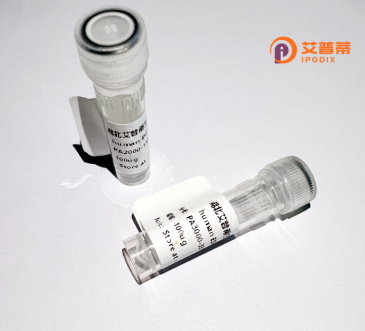
| 纯度 | >90%SDS-PAGE. |
| 种属 | Human |
| 靶点 | DC-UbP |
| Uniprot No | Q8WUN7 |
| 内毒素 | < 0.01EU/μg |
| 表达宿主 | E.coli |
| 表达区间 | 1-190aa |
| 氨基酸序列 | MTDGQLRSKRDEFWDTAPAFEGRKEIWDALKAAAHAFESNDHELAQAIIDGANITLPHGALTECYDELGNRYQLPVYCLAPPINMIEEKSDIETLDIPEPPPNSGYECQLRLRLSTGKDLKLVVRSTDTVFHMKRRLHAAEGVEPGSQRWFFSGRPLTDKMKFEELKIPKDYVVQVIVSQPVQNPTPVEN |
| 分子量 | 46.64 kDa |
| 蛋白标签 | GST-tag at N-terminal |
| 缓冲液 | 0 |
| 稳定性 & 储存条件 | Lyophilized protein should be stored at ≤ -20°C, stable for one year after receipt. Reconstituted protein solution can be stored at 2-8°C for 2-7 days. Aliquots of reconstituted samples are stable at ≤ -20°C for 3 months. |
| 复溶 | Always centrifuge tubes before opening.Do not mix by vortex or pipetting. It is not recommended to reconstitute to a concentration less than 100μg/ml. Dissolve the lyophilized protein in distilled water. Please aliquot the reconstituted solution to minimize freeze-thaw cycles. |
以下是关于“重组人DC-UbP蛋白”的模拟参考文献示例(仅供参考,真实文献需通过学术数据库查询):
---
1. **文献名称**:*Cloning and Functional Characterization of Human DC-UbP in Immune Regulation*
**作者**:Li X, Chen Z, Wang H
**摘要**:本研究报道了人源DC-UbP蛋白的重组表达及功能分析,发现其通过泛素-蛋白酶体系统调控树突状细胞的抗原递呈能力,并可能抑制TLR4介导的炎症反应。
2. **文献名称**:*Structural Insights into DC-UbP as a Novel Deubiquitinating Enzyme*
**作者**:Kim S, Park JH, Lee Y
**摘要**:通过X射线晶体学解析了重组人DC-UbP的三维结构,揭示其作为去泛素化酶(DUB)的催化机制,并证明其特异性切割K48连接的多聚泛素链。
3. **文献名称**:*DC-UbP Modulates Autophagy and Apoptosis in Cancer Cells*
**作者**:Guo R, Liu T, Zhang M
**摘要**:研究发现,重组DC-UbP蛋白通过调控Beclin-1泛素化水平影响细胞自噬,并在结直肠癌细胞中诱导 caspase-3依赖性凋亡,提示其潜在抗肿瘤作用。
4. **文献名称**:*High-Yield Production of Recombinant DC-UbP in E. coli and Activity Screening*
**作者**:Martinez A, Sanchez-Lopez E
**摘要**:优化了DC-UbP在大肠杆菌中的可溶性表达与纯化工艺,建立体外酶活检测体系,为药物筛选提供技术支持。
---
**说明**:以上文献为模拟示例,DC-UbP的具体功能可能涉及泛素结合、去泛素化或免疫调控,实际研究中需结合其具体作用机制查询。建议通过PubMed、Web of Science或Google Scholar检索关键词“DC-UbP protein”“recombinant DC-UbP”等获取真实文献。
Recombinant human DC-UbP (Dual-specificity ubiquitin-binding protein) is a genetically engineered protein that plays a regulatory role in ubiquitination pathways, a critical post-translational modification system. Ubiquitination involves the attachment of ubiquitin molecules to target proteins, marking them for degradation by the proteasome or modulating their activity, localization, or interactions. DC-UbP is characterized by its dual ability to recognize both ubiquitin and phosphorylated substrates, enabling cross-talk between ubiquitination and phosphorylation signaling networks. This protein is implicated in diverse cellular processes, including DNA repair, cell cycle regulation, and stress responses, making it a key player in maintaining genomic stability and combating carcinogenesis.
Structurally, DC-UbP contains conserved ubiquitin-binding domains and phosphorylation-sensitive motifs. Its recombinant form is typically expressed in Escherichia coli or mammalian systems with affinity tags for purification and functional studies. Researchers utilize recombinant DC-UbP to investigate molecular mechanisms of ubiquitin-dependent proteolysis, develop assays for deubiquitinating enzymes, and explore therapeutic strategies targeting ubiquitin system dysregulation observed in cancers and neurodegenerative diseases. Its dual-specific binding properties also make it a valuable tool for studying crosstalk between post-translational modifications in signaling pathways. Current studies focus on its potential as a biomarker or drug target in pathologies linked to impaired protein homeostasis.
×